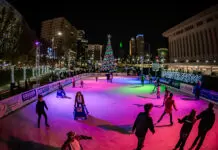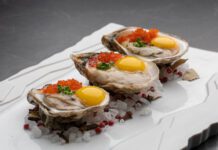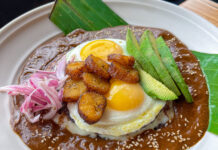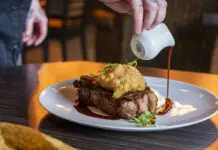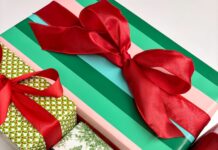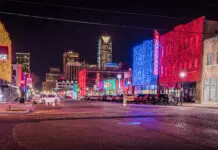Those who have contemplated a Marc Chagall painting will not be surprised to know that one of the 20th century’s most revered artists was deeply inspired by the Bible. From his birth in 1887 Russia to his establishment in France (he died in 1985), Chagall created mythic and dreamlike images in many media, including stained glass. In 1930, Parisian art dealer and art book publisher Ambroise Vollard commissioned Chagall for a series of drawings for the Bible. The series, completed in 1956, materialized out of his visits to Palestine, where the Jewish artist felt at home among the many Yiddish and Russian speakers living there. Today, you don’t have to live in Israel or Europe to witness his passion. The Sherwin Miller Museum of Jewish Art continues its exhibit Marc Chagall: Drawings for the Bible in Tulsa through Jan. 31. www.jewishmuseum.net
Bolero Spanish Grill & Tapas Bar
The misconception that tapas are the precursor to a larger meal is a common one. At Bolero, it’s impossible to overlook the small plates, as they make up nearly the entire menu. Bolero executive chef Curtis Bramlett has created a tapas menu that offers a wide range of options to satiate most palates. Goat cheese that’s lightly fried and drizzled with Tupelo honey, braised crimini mushrooms, steamed mussels and clams Basque: the diversity of the tapas on Bolero’s menu reflects the wide range of culture in Spain, where tapas originated as small plates, complemented by wine, to share and enjoy with friends. The Three Olive Combinacion is accompanied with pickled garlic and seasoned toast points, while Artichoke Frito is served simply with lemon-garlic aioli. Bolero’s wait staff is trained to offer suggested wine pairings with the tapas, and an open-air dining room provides the optimal modern setting for a delicious dining experience in Oklahoma City’s Bricktown. 200 Oklahoma Ave., Suite 140, Oklahoma City. www.bolerotapasbar.com
What We’re Eating
Gumbo at Chicory & Chives
Few things are as comforting on blustery, wintry days as gumbo. The quintessential Cajun stew features a rich blend of vegetables, spices and often meat or seafood, and none do it better in Tulsa than Chicory & Chives, the restaurant with all things Cajun-inspired. The thick stew served over rice is laced with okra and pieces of chicken and sausage. Owner Jim Loggins is cooking up the gumbo in small batches at lunch and dinner seven days a week because, as he puts it, “we sell an awful lot of it.” 5800 S. Lewis Ave., Suite 129, Tulsa. www.chicoryandchives.com
Meatloaf Sandwich at Saturn Grill
The bulk of the menu at Saturn Grill locations focuses on healthy, fresh ingredients. So even when the eatery serves a staple like a meatloaf sandwich, the sandwich doesn’t pack the calorie wallop like its diner-style counterparts. Slices of cooked meatloaf are seared, then piled on a flatbread with tomatoes and barbecue mayo. Served with Saturn Grill’s famous dill pickles and mustard potato salad, it’s a lunch (or dinner) that will take you back to your mother’s kitchen. 6432 Avondale Dr. and 4401 W. Memorial Dr., Oklahoma City. www.saturngrill.com
Cabbage Rolls at Dena’s Lebanese Cuisine
Tucked away in a small shopping strip facing 11th Street in Tulsa is Dena’s, a weekday lunch and dinnertime favorite for TU students and those who work nearby. Dena’s boasts standard Lebanese/Mediterranean fare – gyros, falafel, spinach pie, stuffed grape leaves – but it’s the cabbage rolls that stand out on the expansive menu. Ground meat and rice are cooked with spices, then wrapped in cabbage leaves and steamed. The cabbage rolls at Dena’s are flavorful and fork-tender, which comes in handy if you order them takeout. A healthy serving of hummus and pita and tabouli accompanies each cabbage roll dinner. 2615 E. 11th St., Tulsa. 918.599.9623
Perfect Harmony
What started as a small music class in the Tulsa Community Arts School has become one of Tulsa’s premier choral organizations. Tulsa Children’s Chorus has delighted audiences throughout Tulsa since 1991.
TCC came from humble beginnings but quickly gained support from not only parents, but the community as well. The chorus incorporated in 1996 and has now grown to feature two ensembles: Tulsa Youth Chorale and the Tulsa Children’s Concert Chorus. Kevin Pearson serves as the organization’s artistic director.
“I want to expose the children of Tulsa to the beauty of choral music,” says Pearson. “Whether we are singing Schubert or an Appalachian folk song, beauty can be found in the blending of voices to create one lovely, harmonious sound.”
Pearson says that children are not exposed to choral music as they were in the past. Gone are the days in which families sit around the piano, harmonizing and enjoying each other’s company. This is one of the reasons Pearson feels the chorus is so important.
“Our youth are often unaware of the unity that can be felt through the music of our greatest composers,” says Pearson. “TCC gives children (and audiences) a chance to be exposed to the expressiveness that choral music provides.”
TCC hosts three open auditions per year and is open to children age 8 to 18. Auditions are held in May, August and December; but private auditions can also be arranged. The chorus is a tuition-based organization, but partial scholarships are available. Rehearsals are held every Tuesday at Boston Avenue United Methodist Church.
“Our goal is to reach 80 singers in the next three to four years,” claims Pearson. “We are in the midst of a renaissance right now – and it is my personal mission to see the organization continue to thrive.”
Crystal Grantham is definitely helping the organization thrive. All four of her children participate in the Tulsa Children’s Chorus.
“My children (ages 16, 13, 12 and 10) have been active in the chorus for the past two years,” Grantham says. “We started just with our oldest daughter and loved it so much we had our other children join.
“The directors have a knack for taking children and producing a very professional and impressive product,” Grantham continues. “Our children are blessed to have an environment that challenges them and gives them the opportunity to succeed. I believe our society accepts mediocrity far too often when excellence is achievable. TCC and TYC provide children with the training and venues to accomplish this goal.”
The Tech Effect
While most people know better than to judge a book by its cover, few grant that same courtesy to the buildings these classics call home. On the surface, most public library buildings appear just as they did decades ago, but take a look inside and it’s easy to see this isn’t your parents’ library.
From free internet access to the growing catalog of eBooks, audiobooks and electronic catalogs, libraries in Oklahoma are adapting to the demands of the information age.
“One of the top questions I get is ‘Well how is business at the library?’” Tulsa City-County Library CEO Gary Shaffer says.
“They think business would be going down, but libraries across the country are busier than they’ve ever been. And they’re busier because of technology.”
The driving force behind that technological shift has been the explosion of electronic media. Several libraries across the state have expanded their catalogs to include thousands of downloadable titles available in eBook and audiobook formats.
The Metropolitan Library System of Oklahoma County began offering downloadable eBooks in July 2009. During that first month, the library system had 237 downloads, but has seen that number grow rapidly with more than 14,000 downloads during this past June.
The Tulsa library system has seen a similar climb in the number of eBook downloads, since first offering the format. Usage doubled during the second month to 4,435 downloads in January and has increased 65 percent through the first half of the year.
Although these advances in technology have changed the way we access information, it has not meant a death to public libraries. Metropolitan (OKC) Library System Executive Director Donna Morris says libraries have never been busier, a fact she credits to the poor economy and increased demand for information.
“People are looking for more free material, and a lot of those searching for jobs come into the library for a variety of reasons,” Morris says. “Many companies require applications to be done online, and a lot of people that are out of work probably don’t have access to either a computer or the internet.”
While many parts of the public sector have been hit with budget cuts, public libraries in the state have largely stayed afloat due to stable property taxes and support from lawmakers. That cooperation has been exemplified in Oklahoma City by the construction of a new $8.2 million, 35,000-square-feet Northwest Library, set to open early next year.
“The library pays all the operating costs, and generally we ask the communities to provide and improve the buildings,” Morris says. “And we have worked to raise money for a new library in Choctaw and other communities including the Northwest Library. So we have good cooperation all across the county with our 17, almost 18 libraries.”
Into the modern era
Beginning later next summer, Tulsa’s downtown Central Library will undergo a facelift intended to seriously upgrade the facility and bring it into the 21st century.
Led by the Minneapolis-based architectural firm Meyer Scherer & Rockcastle, the project is anticipated to cost a minimum of $12 million, which will be paid for from the capital fund – money which is set aside for facilities improvements.
The bulk of the funds will pay for infrastructure and mechanical systems, notably including much-needed lighting. Signs and drive-through access are also expected to be improved. In combination with other aspects of the facelift, the project is expected to modernize the 135,000 square-foot library. Several studies in recent years have declared the library mechanical systems obsolete and in need of replacement.
Plans to upgrade the Central Library began to take shape after years of debate and a proposal to construct a new library that failed when voters rejected a 2004 bond issue.
Meyer Scherer & Rockcastle has been responsible for designing more than 160 libraries.
Construction is expected to be completed in spring 2013.
Seasonal Seasonings
Taking the time to do things slowly – to do them right – has always bored me to tears. I’m impatient at the onset of a project, jumping the gun, darting toward the finish line before ever tying my sneakers. As you can imagine, this has had many a dire consequence. Take, for example, the time I rushed to plant $200 worth of shrubbery, only to forget to water them. Only when the poor plants wilted beyond repair did I notice my gaffe. Then there are the times I try to carry all my groceries into the house in one go. My herculean effort never works out, and yet I seemingly prefer a few rolled tomatoes to slowing down and doing things right. It’s crazy.
But, here we are – in December – with our feet firmly planted in the holiday season. About this time my warning bell goes off rather violently. You see, over the years I’ve come to realize that things are different in December. I can’t pull my usual tricks and expect to come out on the other side sane and content. No, I have to deal with the holiday season slowly and correctly.
I’m still refining the process, but here’s what I do: I make food gifts for family and friends – things I would not otherwise think of in the rush of the holidays. I know what you’re thinking – “Making gifts! Who has time for that? It’s so much easier to just buy everyone gift cards.”
I agree when it comes to sewing, knitting and crafting – these are not my forte – especially not while raising a 2-year-old. And yet, gift cards are so much less personal. No, something simple and creative is in order this time of year.
Last year I made themed food baskets for my family. Taking my adventure to eat the world as inspiration, each family got a basket filled with food from a different part of the world. My in-laws got an Italian basket, stuffed with gorgeous dried pastas, gourmet sauces and specialty Parmesan. My brother-in-law’s family got the Greek filled with tapenade, fancy breads, feta and more. The great thing about these gifts is that I could add to them every week I went shopping, browsing the aisles carefully, until I had enough items to fill the baskets. No special trips to the mall required. Halfway through December the baskets were overflowing and more beautiful – more customized – than anything I could have purchased.
Since I was way ahead of schedule I took it one step further, adding a few homemade items to the baskets – fresh ground spices and seasoning blends. These also work on their own as smaller gifts or stocking stuffers. Take the time to find unusual containers and your recipient will be thrilled.
For an Indian Basket
Curry Powder
2 tsp. black peppercorns
2 tsp. ground turmeric
2 tsp. coriander seeds
2 tsp. ground ginger
1 tsp. fenugreek seeds
1 tsp. cumin seed
1/2 tsp. fennel seed
1/2 tsp. cayenne
Seeds from 4 cardamom pods
2 whole cloves
Toast spices in a dry frying pan over medium heat until fragrant, about one minute. Let cool slightly and grind in a coffee grinder or mortar and pestle. Store in an airtight container.
Makes 1/4 cup.
For a European Basket
Georgian Khmeli-Suneli Five Spice
Sprinkle on vegetables, salads, mix into marinades and soups. Mix with lemon juice and olive oil for a fabulous chicken marinade.
4 tsp. fenugreek seeds
4 dried bay leaves
2 tbsp. ground coriander seeds
2 tbsp. dried savory
1 tbsp. dried dill
1 tsp. black pepper
Grind all ingredients in a coffee grinder or mortar and pestle. Store in an airtight container.
Makes 3/8 cup.
For an African Basket
Kan Kan Kan
Sprinkle this spicy peanut powder on meats after cooking to heat things up.
1/2 c. peanut powder
1 tsp. chili powder
1/4 tsp. allspice
2 Maggi bouillon cubes; or
2 tsp. powdered bouillon
Crush up the bouillon cubes, if using. Stir all ingredients together. Store in an airtight container.
Makes 1/2 cup.
Sasha Martin is cooking one meal for every country in the world. Her picky husband and baby girl are along for the ride. Join the adventure for recipes, reviews and more at www.globaltableadventure.com.
The Evergreen Ring
The wreath – long a symbol of the holiday season – may trace its roots back to Persia, but the tradition of hanging wreaths on doors is a largely European practice. In ancient Rome, citizens hung decorative wreaths on doors to signify victory and celebration. The round objects soon came to symbolize immortality for Christians, and as evergreen traditionally represents life in many cultures, evergreen wreaths became popular décor during the holiday season.
Country Living in the City
When Tulsa-based interior designer Sallie Hughes, who with her sister, Beth Sachse, owns SR Hughes, went looking to relocate from her home in the country to a smaller city dwelling, she knew she wanted a place that still had a relationship to the outdoors. Light and a sense of space played a large part in her selection.
“To me the play of light, the courtyard and patio that bring the outdoors in – that appealed to me,” Hughes says of her Garden Park residence.
Both sides of her unit are covered in floor-to-ceiling expanses of glass that allow access from nearly every room to the courtyard and patio. High ceilings and ample storage add to the spacious feel that Hughes loves.
With more than 30 years of experience in design, it didn’t take her long to figure out where everything should go, especially when she used only items she already owned.
“It suites and delights me,” Hughes says of her collection of pieces, which include everything from a folding, English antique chaise and French daybed to modern Italian pieces from SR Hughes. “I’m a nester. When I walk in my home, well, there’s nowhere I feel more comfortable.”
Hughes’ signature design style is evident in the juxtaposition of traditional and modern elements throughout her home, like in her dining room where Cassina leather CAB armchairs share the stage with an antique English oak double gateleg drop-leaf table.
Another example is the living room. A rug by Odegard serves as the foundation. The space is complemented well by classic brown leather Le Corbusier chairs book-ending the sofa that is decorated with ethnic fabric pillows. Another juxtaposition that Hughes likes can be seen in the wingback chairs, inherited from her mother, and the bright orange Wassily leather sling chair by Knoll. The brightly colored painting that adds a punch of drama to the back wall of the room is a work by Hughes’ sister-in-law, Marsha Moore Hughes.
“If everything looks the same, then nothing stands out. To me an iconic piece of furniture or lighting gives an energy to the space,” Hughes shares.
The piece de resistance of the living room and of Hughes’ antique collection is the pine Chippendale-style secretary desk framed by two English leather chairs.
“It belonged to my mother and is my favorite antique,” she says with affection.
A common theme throughout the home is ethnic art and fabrics. Everything from Indian and African fabrics to Chinese primitive tables is featured.
“Something about ethnic influence speaks to my soul,” Hughes says.
Books are also something that speaks to this designer. An avid reader, Hughes was sure to create a bookshelf focal point in her master suite as well as golden-hued wingback chairs to enjoy.
Her study is another place where she enjoys her favorite hobby. A vintage green leather chair and a French daybed create a comfy feel where Hughes enjoys reading, and when she’s gone her two rescued dogs spend their time in the space.
Only a short time after finishing her own space, Hughes’ neighbor, Suzanne Brickner, asked for help with her condominium.
Brickner faced a dilemma most people do when downsizing. Her lovely Country French-inspired furniture was a little oversized for the layout of her new home. An avid cook and art collector, she wanted space and flow for both.
Working her magic, Hughes and Sachse showed Brickner how scale is the key to an engaging space. Using the traditional style of the home and high ceilings with wooden beams, Hughes paired a more modern touch that went along with Brickner’s taste.
Again, the foundation of the room is a striking Odegard rug from SR Hughes, which is anchored by the glass Cassina coffee table. The owner loves to collect glass birds, so Hughes created a natural space to show them. A pair of Kalos armchairs by Max Alto and a black leather Barcelona chair by Knoll add stylish comfort.
In the dining space, Hughes made two P. S. Gordon charcoal portraits, Brickner and her husband, the highlight and anchored them with an antique Chinese console from SR Hughes. The Ingo Maurer Birdie chandelier accented with feathers floats over a Cassina glass and wood La Rotunda table. Six burnt orange Cassina Hola chairs add just the right touch of color.
When it came to the outdoor space, Brickner achieved a Zen-like haven in which she can relax with creature comforts. In contrast, but still as relaxing, Hughes’ courtyard is deliciously overgrown with azaleas, boxwoods and other greenery.
“It’s full and wild and I love it,” Hughes says. It’s the perfect setting to enjoy the chiminea each night and a good book with her two canine companions.
Palatial Flavors
You can get outstanding drinks at the bar in the new lounge of the Palace Cafe, but even if you’re not a drinker it’s worth a trip to admire the sleek, spare design. It’s spacious and modern, with rough slate walls accented by wood and metal trim. Step around the corner into the newly redesigned dining area, and the walls are slate and weathered wood planks, the banquettes are soft gleaming leather, and the huge wall hangings are flowering trees painted in Qing Dynasty Chinese style. The dominant – in fact, the only – color is gray, the pearly radiant gray of a Seattle dawn.
“I wanted to capture the look of my favorite restaurants in Seattle,” says chef and owner James Shrader, “where you can walk in wearing a lumber jacket and jeans.”
Amidst this austere yet elegant setting, though, you’d also feel comfortable in your finest suit and tie.
Natural, earthy materials and simple elegance influenced by Seattle, China and the whole Pacific Rim: what’s true of the decor is also true of Shrader’s cooking and perhaps Shrader himself. Fascinated by food as far back as he can remember, he tried to invent new ways of cooking simple dishes while still in grade school. He’s still doing that, obsessed with perfecting dishes that are lackluster everywhere else.
“Being creative isn’t the most important thing,” Shrader says. “It’s doing the dish well.”
Shrader graduated from what many consider America’s finest cooking school, the Culinary Institute of America. But most of what he’s learned comes from observing the world around him: The fascinating panoply of the farmers’ markets in Seattle and, later, of the big Saturday market right outside Palace Café’s door. He learned to base his dishes on fresh and local ingredients long before that became the fashion. Shrader used to call his cooking style “nouveau American cuisine,” but now he favors the phrase Pacific Rim. Indeed, a subtle Asian influence infuses many of his finest entrees. Braised beef short ribs, his take on a classic Yankee pot roast, are simmered in a veal gastrique accented by a blend of caramelized sugar and vinegar often used in China. He makes Moroccan-style preserved lemons to use in several of his dishes because, though North African, they blend sour and salty flavors in a way favored by Chinese cooks. Slow-roasted duck features a blend of Chinese spices, all freshly ground in house, including star anise, toasted cloves and Sichuan peppercorns.
East Asian flair and presentation are most clearly evident in the unique Bento section of the menu. These are tiny, bite-size appetizer plates prepared with haiku-like precision. Miniature filets with sauteed onions, salmon cakes with braised fennel and chicken-fried chicken with tomato chutney are each made with the care normally devoted to full-sized entrees. They can be ordered individually or in a set of six. A separate vegetarian menu, complete with bentos, appetizers and a full selection of entrees, is enticing enough to convert a carnivore. One entree features a grilled apple-sage polenta cake topped with layers of goat cheese, wilted spinach and cherry chutney. Another is wild mushroom ravioli.
The vegetarian menu is available only at dinner. But there’s also a full lunch menu, consisting of less elaborate, modestly priced selections, and also Sunday brunch. Shrader has maintained the same high standards as when Palace opened in 2003, and it is this as much as the breathtaking new decor that makes his restaurant cutting-edge, trendy and, like his produce, forever fresh. 1301 E. 15th St., Tulsa. www.palacetulsa.com
A Capital Experience
Arriving early and checking into your hotel frees your evening for acclimating yourself to the District. Grab a casual dinner on the fly as you make your way to the National Mall. Nothing will inspire the feel of the nation’s capital as does this Mall, a two-mile stretch abutted by such magnificent sites as the U.S. Capitol Building, Lincoln Memorial, the Washington Monument and numerous Smithsonian museums – all just south of the White House. Enjoy the lighted monuments and public activity at this, the iconic green space intended to be the heart of civic America.
Saturday morning, enjoy breakfast at your hotel and head out for a day of museum tours. You’ll want to pick and choose which of the Smithsonian institutions you want to visit since, with 19 in total, seeing them all in a weekend isn’t likely. The National Air & Space Museum is one of the more popular options, as are the National Gallery of Art, the National Museum of Natural History and National Museum of the American Indian. But you’ll want to be your own judge and choose from among the Smithsonian and other important and popular sites, such as the somber Holocaust Memorial Museum, the Basilica of the National Shrine of the Immaculate Conception and Newseum, to name just a few. By day’s end you will want to settle in for a memorable dinner, so plan well in advance for reservations at Jose Andres’ famous Zaytinya or Bourbon Steak at the Four Seasons Washington D.C.
After breakfast Sunday, it’s time to return to the National Mall to explore the nation’s heart by day. The Smithsonian remains open, and the major monuments present a different view by day. Catch the ones you missed Friday night and opt for others relevant to you, such as the Thomas Jefferson Memorial, Vietnam Veterans Memorial, World War II Memorial, Declaration of Independence Memorial and others. Alternately, consider a trip outside of the urban core to other historic sites of interest to you, from the Watergate in town to Mount Vernon, where, one could argue, the inspiration for the whole American experience took shape.
Stay In Style
The nation’s capital can be an expensive place to overnight, particularly when staying close to the action. But for most people, it’s worth the expense to avoid commuting too far from outside the congested area.
The Jefferson, Washington D.C. benefits from close proximity to the White House, the Metro and many downtown restaurants and attractions. After major renovations, it’s more comfortable and spacious, so the elegant attention to detail matches the outstanding service and the ambiance evocative of Thomas Jefferson’s Parisian years. http://jeffersondc.com
The Palomar Washington D.C., a Klimpton Hotel, offers the gorgeous, hip setting and thoughtful service one expects from a boutique hotel, as well as the requisite playful eclectic room décor. But many of The Palomar’s rooms are also huge, well insulated from sound, and some include a hosted wine reception to welcome guests to D.C. www.hotelpalomar-dc.com
Four Seasons Washington D.C. is the only five star, five diamond hotel in the Capital region, situated in comfortable and accessible Georgetown, and possessing the flawless level of service and hospitality one would expect. Two distinct wings are connected by a scenic glass-enclosed garden walkway and many of the 222 rooms (including 59 suites) offer views of Georgetown, historic Chesapeake and the Ohio Canal. www.fourseasons.com/washington/
At a Glance
The nation’s capital is one of the most visited places in the country for its monuments, museums and history.
Access: One of the most accessible cities in the country, D.C. is served by three airports, Ronald Reagan Washington National Airport, Washington Dulles International Airport and Baltimore-Washington International Thurgood Marshall Airport. Amtrak also covers D.C. from around the country with all trains stopping at Union Station near the Capitol.
Population: Approx. 600,000 full-time, with a noticeable increase in population when Congress is in session, in the spring when the cherry blossoms bloom and in the summer.
Climate: Despite being in a humid subtropical climate zone, Washington D.C. experiences four distinct seasons with usually gentle transitions but also with occasional extreme weather in the summer (high heat) and winter (blizzards and heavy snow).
Main Attractions: The National Mall and its museums and monuments and countless other historic sites are at least as popular as the more obvious sites such as the White House and the U.S. Capitol.
Hot Picks
See: The newest monument in D.C. has been a long time in coming, so it’s particularly worth the effort to check out the Martin Luther King Jr. National Memorial.
Eat: Most people are largely unfamiliar with Ethiopian cuisine, but D.C. is a great place to explore its exciting and eclectic flavors – notably in a “Little Ethiopia” section of Shaw, a north-central neighborhood.
Lingo: You’ll rarely hear the U.S. capital called by its full name by locals. Instead the city built on politics is simply called “the District” except in official or academic parlance.
Visit Online
www.washington.org


